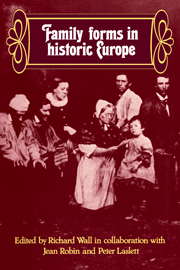Book contents
- Frontmatter
- Contents
- List of contributors
- Preface
- 1 Introduction
- 2 Two kinds of pre-industrial household formation system
- 3 ‘A large family: the peasant's greatest wealth’: serf households in Mishino, Russia, 1814–1858
- 4 The peasant family as an economic unit in the Polish feudal economy of the eighteenth century
- 5 The familial contexts of early childhood in Baltic serf society
- 6 Estonian households in the seventeenth and eighteenth centuries
- 7 Family and familia in early-medieval Bavaria
- 8 The property and kin relationships of retired farmers in northern and central Europe
- 9 Pre-industrial household structure in Hungary
- 10 The reconstruction of the family life course: theoretical problems and empirical results
- 11 The changing household: Austrian household structure from the seventeenth to the early twentieth century
- 12 Does owning real property influence the form of the household? An example from rural West Flanders
- 13 The evolving household: the case of Lampernisse, West Flanders
- 14 The composition of households in a population of 6 men to 10 women: south-east Bruges in 1814
- 15 The importance of women in an urban environment: the example of the Rheims household at the beginning of the Industrial Revolution
- 16 The household: demographic and economic change in England, 1650–1970
- 17 Family and household as work group and kin group: areas of traditional Europe compared
- References
- Index
5 - The familial contexts of early childhood in Baltic serf society
Published online by Cambridge University Press: 05 November 2011
- Frontmatter
- Contents
- List of contributors
- Preface
- 1 Introduction
- 2 Two kinds of pre-industrial household formation system
- 3 ‘A large family: the peasant's greatest wealth’: serf households in Mishino, Russia, 1814–1858
- 4 The peasant family as an economic unit in the Polish feudal economy of the eighteenth century
- 5 The familial contexts of early childhood in Baltic serf society
- 6 Estonian households in the seventeenth and eighteenth centuries
- 7 Family and familia in early-medieval Bavaria
- 8 The property and kin relationships of retired farmers in northern and central Europe
- 9 Pre-industrial household structure in Hungary
- 10 The reconstruction of the family life course: theoretical problems and empirical results
- 11 The changing household: Austrian household structure from the seventeenth to the early twentieth century
- 12 Does owning real property influence the form of the household? An example from rural West Flanders
- 13 The evolving household: the case of Lampernisse, West Flanders
- 14 The composition of households in a population of 6 men to 10 women: south-east Bruges in 1814
- 15 The importance of women in an urban environment: the example of the Rheims household at the beginning of the Industrial Revolution
- 16 The household: demographic and economic change in England, 1650–1970
- 17 Family and household as work group and kin group: areas of traditional Europe compared
- References
- Index
Summary
The Baltic Provinces: some comparisons
By the end of the eighteenth century a series of five tax censuses carried out by the government of the Russian Empire had created for later generations of social historians a vast body of primary sources in the form of household lists. These ‘revisions of souls’ (Russ. revizskie skazki), as they were called, contained the names of taxpayitig Russians, as well as those of a host of other peoples annexed by a succession of tsars and tsarinas in the course of the century. One non-Russian territory consisted of the three so-called ‘Baltic Provinces’ (Russ. Pribaltika): Livland and Estland, which had been acquired from Sweden in 1720, at the conclusion of the Great Northern War; and Kurland, which was incorporated into the Empire during the territorial adjustments accompanying the Third Partition of Poland in 1795 (see fig. 5.1). The landed nobilities (Ritterschaften) of these Baltic lands were German-speaking, as was nearly all of the minuscule town population. The enserfed peasantries, on the other hand, consisted of Estonian-speakers in Estland and the northern half of Livland, and of Latvian-speakers in southern Livland and in Kurland. Both landowner and peasant in this area had seen changes of sovereigns several times before the eighteenth century, together with the waxing and waning of threats to landowners' powers. The Swedish Vasas in particular had tried to alter traditional lordserf relations, but with little permanent effect.
- Type
- Chapter
- Information
- Family Forms in Historic Europe , pp. 167 - 206Publisher: Cambridge University PressPrint publication year: 1983
- 10
- Cited by



